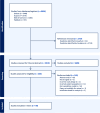Clinical prediction models for febrile neutropenia and its outcomes: a systematic review
- PMID: 40467900
- PMCID: PMC12137469
- DOI: 10.1007/s00520-025-09562-y
Clinical prediction models for febrile neutropenia and its outcomes: a systematic review
Abstract
Purpose: Febrile neutropenia (FN) is a life-threatening complication of chemotherapy. Although practice guidelines suggest the use of existing prediction models when making decisions to prevent and treat FN, recent evidence suggests that these models are limited in their discriminative ability. This study aims to systematically review and critically evaluate the recent literature to assess the question: what evidence-based clinical prediction models can be used to predict FN or its outcomes?
Methods: PubMed, EMBASE, Web of Science, and SCOPUS were searched for primary journal articles that developed or validated models that predicted FN or outcomes in patients with FN. Risk of bias was critically evaluated using the Prediction model Risk of Bias Assessment Tool (PROBAST).
Results: Five thousand nine hundred nineteen articles were identified, of which 90 met inclusion criteria. Twenty-five studies predicted FN, and 65 studies predicted outcomes in patients with FN, including 28 that predicted mortality, 35 that predicted microbiological outcomes, and 35 that predicted other complications. Eight studies used machine learning methods in their development, and few studies were externally validated. All 90 studies were graded as high risk of bias using PROBAST.
Conclusion: Prediction models for FN and its outcomes demonstrate promising discriminatory ability; however, several limitations have prevented these from translating clinically. These limitations include variable FN definitions, high ROB in current models, limited external validation, and heterogeneous cohorts. Future work is needed to further develop and validate robust, well-evidenced models that can translate into clinical practice. This may best be achieved through machine learning and electronic medical record integration.
Keywords: Febrile neutropenia; Prediction model; Risk score.
© 2025. Crown.
Conflict of interest statement
Declarations. Ethics approval: This is a systematic review. No ethics approval was required for the preparation of this manuscript. Competing interests: The authors declare no competing interests.
Figures
Similar articles
-
Cost-effectiveness of using prognostic information to select women with breast cancer for adjuvant systemic therapy.Health Technol Assess. 2006 Sep;10(34):iii-iv, ix-xi, 1-204. doi: 10.3310/hta10340. Health Technol Assess. 2006. PMID: 16959170
-
Primary prophylactic colony-stimulating factors for the prevention of chemotherapy-induced febrile neutropenia in breast cancer patients.Cochrane Database Syst Rev. 2012 Oct 17;10(10):CD007913. doi: 10.1002/14651858.CD007913.pub2. Cochrane Database Syst Rev. 2012. PMID: 23076939 Free PMC article.
-
The comparative and added prognostic value of biomarkers to the Revised Cardiac Risk Index for preoperative prediction of major adverse cardiac events and all-cause mortality in patients who undergo noncardiac surgery.Cochrane Database Syst Rev. 2021 Dec 21;12(12):CD013139. doi: 10.1002/14651858.CD013139.pub2. Cochrane Database Syst Rev. 2021. PMID: 34931303 Free PMC article.
-
Health professionals' experience of teamwork education in acute hospital settings: a systematic review of qualitative literature.JBI Database System Rev Implement Rep. 2016 Apr;14(4):96-137. doi: 10.11124/JBISRIR-2016-1843. JBI Database System Rev Implement Rep. 2016. PMID: 27532314
-
What is the value of routinely testing full blood count, electrolytes and urea, and pulmonary function tests before elective surgery in patients with no apparent clinical indication and in subgroups of patients with common comorbidities: a systematic review of the clinical and cost-effective literature.Health Technol Assess. 2012 Dec;16(50):i-xvi, 1-159. doi: 10.3310/hta16500. Health Technol Assess. 2012. PMID: 23302507 Free PMC article.
References
-
- Kuderer NM, Dale DC, Crawford J, Cosler LE, Lyman GH (2006) Mortality, morbidity, and cost associated with febrile neutropenia in adult cancer patients. Cancer 106(10):2258–2266. 10.1002/cncr.21847 - PubMed
-
- Legrand M, Max A, Peigne V, Mariotte E, Canet E, Debrumetz A et al (2012) Survival in neutropenic patients with severe sepsis or septic shock. Crit Care Med 40(1):43–49. 10.1097/CCM.0b013e31822b50c2 - PubMed
-
- Freifeld AG, Bow EJ, Sepkowitz KA, Boeckh MJ, Ito JI, Mullen CA et al (2011) Clinical practice guideline for the use of antimicrobial agents in neutropenic patients with cancer: 2010 update by the infectious diseases society of america. Clin Infect Dis : An Off Publi Infec Dis Soc Am 52(4):e56–93. 10.1093/cid/cir073 - PubMed
-
- Taplitz RA, Kennedy EB, Bow EJ, Crews J, Gleason C, Hawley DK et al (2018) Outpatient management of fever and neutropenia in adults treated for malignancy: American Society of Clinical Oncology and Infectious Diseases Society of America clinical practice guideline update. J Clin Oncol 36(14):1443–1453. 10.1200/JCO.2017.77.6211 - PubMed
Publication types
MeSH terms
Substances
LinkOut - more resources
Full Text Sources
Miscellaneous


